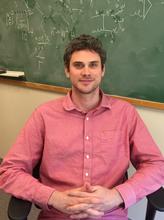
Assistant Professor
Research Interests:
Searches for dark sector particles and development of high-speed reconstruction algorithms
The discovery of the 125 GeV Higgs boson was a landmark discovery and in my past research I led studies of the Higgs sector at CMS. I was co-coordinator of the CMS Higgs Combination and Properties group, helping to produce the first observations of ttH production and the H→bb decay. I led an effort produced combined measurements using all of the Higgs boson production and decay channels and combined differential cross section measurements using the initial Run 2 data. I also performed the world’s single most precise measurement of the Higgs boson mass at the time as well as differential cross section measurements using the H→ZZ decay channel. I was also co-coordinator of the CMS Exotic Higgs physics group and pursued searches for exotic Higgs decay modes. These studies have so far found the Higgs boson to be compatible with the Standard Model (SM) predictions and my latest research has shifted towards searches for more exotic signatures.
While the SM is a remarkably successful theory, it is also evidently inadequate. The clearest problem with the SM is the overwhelming empirical evidence for the existence of dark matter, an observation for which the SM has no explanation. The worldwide search for conventional dark matter candidates has yet to produce a positive signal, strengthening the motivation to search for a broader class of “dark sector” signatures. Dark sectors can be broadly defined as a new physics scenario containing new particles that mediate interactions between the SM and the dark matter sector, and they often contain light and weakly coupled particles (e.g. “dark photons”). Particles in the MeV-GeV mass range are particularly attractive as they allow dark matter to be in thermal equilibrium with the SM in the early universe, providing a simple explanation for the relic dark matter density. The SM also lacks an explanation for the absence of Charge-Parity (CP) violation in the strong interactions (strong CP problem), a problem which may be resolved by models that contain new bosonic particles (“axion-like particles”). I am currently interested in searching for various light and weakly coupled particles that can explain these fundamental shortcomings of the SM. The theories that contain such particles are well-motivated and can be tested at with the CMS detector at the LHC and the SpinQuest/DarkQuest experiment at Fermilab.
I also develop the experimental infrastructure and algorithms needed to perform searches for these elusive particles. The CMS trigger system is a bottleneck for many searches, and my group is heavily involved in it’s design and operation. I am leading the development of the Level-1 Global Trigger Menu and the associated software emulator during LHC Run 3. I also lead the “Data Scouting” Group in CMS, where we develop and operate an alternative data acquisition system with a GPU-accelerated event reconstruction sequence and reduced data formats that enhance the ability of CMS to discover new light particles. I recently used the Data Scouting framework to perform the world’s most sensitive search for dark photons at the GeV scale, and I have worked to expand the scope of this framework during LHC Run 3. I am also developing advanced reconstruction algorithms to meet the extreme conditions that will be encountered at the High Luminosity LHC (HL-LHC). I have been working to adapt the CMS vertex reconstruction algorithm to run effectively on GPUs. This algorithm is crucial for the CMS physics program as it enables efficient identification of vertices associated with hard interactions. However, due to the substantial increase in pileup and the number of tracks, the vertex finding stage of the reconstruction will become significantly more challenging. By adapting the vertexing algorithm to run on GPUs, it’s processing time has been reduced by an order of magnitude. Moreover I am serving as the US CMS Software and Computing HL-LHC R&D Coordinator, where I will coordinate the overall effort to develop the software and computing infrastructure to be able to efficiently analyze the HL-LHC data set.
Selected Publications:
“Search for direct production of GeV-scale resonances decaying to a pair of muons in proton-proton collisions at √s = 13 TeV”,The CMS Collaboration, JHEP 12 (2023) 070
“Search for low-mass dilepton resonances in Higgs boson decays to four-lepton final states in proton–proton collisions at √s = 13 TeV”,The CMS Collaboration, Eur. Phys. J. C 82 (2022) 290
“Measurements of production cross sections of the Higgs boson in the four-lepton final state in proton-proton collisions at √s = 13 TeV”,The CMS Collaboration, Eur. Phys. J. C 81 (2021) 488
“Search for a narrow resonance lighter than 200 GeV decaying to a pair of muons in proton-proton collisions at √s = 13 TeV”,The CMS Collaboration, Phys. Rev. Lett. 124 (2020) 131802
“Combined measurements of Higgs boson couplings in proton-proton collisions at √s = 13 TeV”,The CMS Collaboration, Eur. Phys. J. C 79 (2019) 421
“Observation of tt̄H production”, The CMS Collaboration, Phys. Rev. Lett 120 (2018) 231801 (Editor’s Suggestion)
For a full list of publications, please see the attached CV.